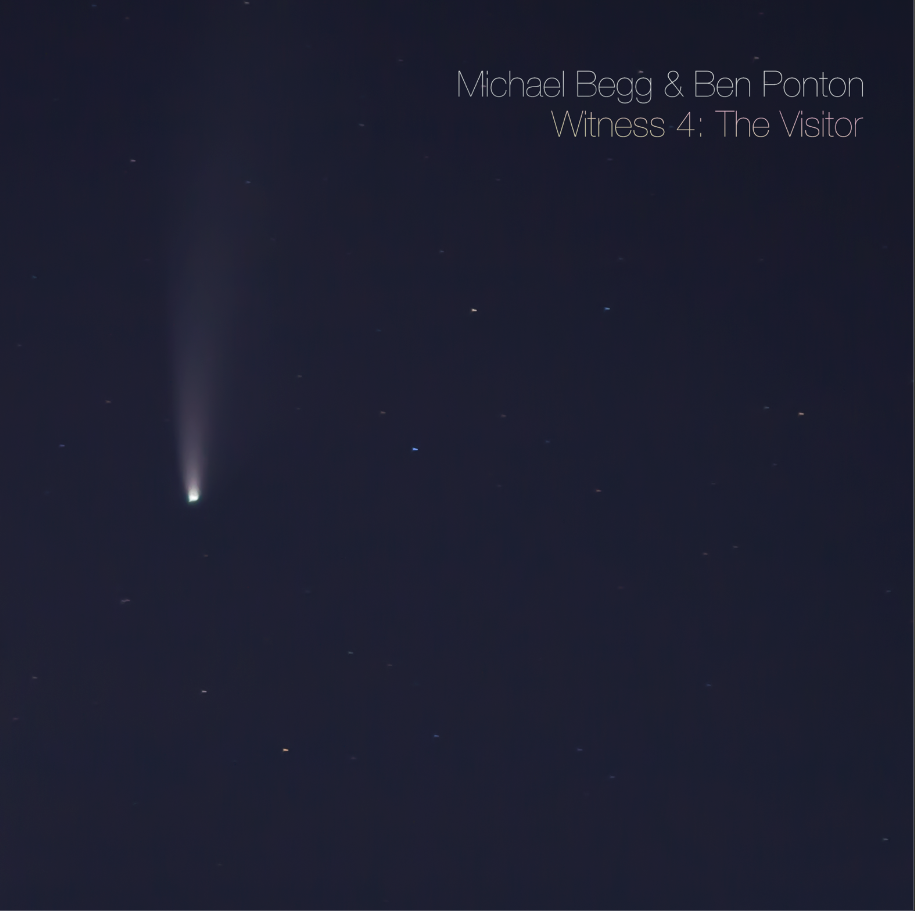Michael Begg & Ben Ponton
WITNESS 4: The Visitor
Omnempathy
Cat. No. OMWI04
Link – https://omnempathy.bandcamp.com/album/witness-4-the-visitor
Bandcamp only digital release
Release Date – 7th August 2020
Michael Begg presents the latest in his Witness series, Witness 4: The Visitor.
This album marks the night when the newly-discovered Comet Neowise came closest to Earth, on 23/24 July 2020. With the comet visible in the sky above, Begg collaborated with fellow composer, Ben Ponton, to simultaneously gather sound and satellite data tracking the comet from their localities in East Lothian and Newcastle upon Tyne, to form the basis of the two compositions featured in the album. Witness 4 is a timestamp commemorating an unexpected and captivating celestial visitor.
As with the previous albums in the series, Witness 4 uses Begg’s Witness Engine, a suite of software he has compiled to capture real time data feeds from satellites and environmental monitoring stations, which is then converted into music. While the engine was running in East Lothian, sonifying satellite and air quality data, Ponton gathered location recordings in Newcastle from one of the city’s air quality monitoring stations, a central point in the city’s 1000 acre Town Moor, and VLF radio waves generated by electrical activity in the planet’s magnetosphere.
Track 1: Cradlewell Roadside Air Quality Monitoring Station
Air quality datafeed from openAQ:
PM10 12µg/m³
NO2 16µg/m³
Generalised regional data was utilised for ozone, SO2 and PM25 readings
On site recordings (contact mics, geophone)
Track 2: Above and Below the Town Moor
Satellite positional datafeed from N2YO:
NEOSSAT (Norad ID: 39089) Readings processed for Alt, Lat/Long, Azimuth, Ra and Dec. in relation to a fixed point on the Town Moor, Newcastle upon Tyne. NEOSSAT is the first space telescope designed to search for hazardous Earth-crossing asteroids.
On site recordings (geophone, VLF receiver)
Data sonification was undertaken from East Lothian, UK. On-site recordings were made at Cradlewell Roadside Air Quality Monitoring Station and the Town Moor, Newcastle upon Tyne, UK.
The recordings were co-ordinated to begin simultaneously at 22:00 GMT+1, 23rd July 2020 (track 1) and 23:30 GMT+1, 23rd July 2020 (track 2).
Notes
A geophone is a device that converts ground movement (velocity) into voltage. When the voltage deviation is measured against the base line the seismic response can be analysed to determine the earth’s structure. The geophone deployed at Cradlewell Roadside Air Quality Monitoring Station, and on the Town Moor, has been adapted for field recording use.
A VLF (very low frequency) receiver is sensitive to frequencies between 3 and 30 Hz. VLF radio waves are generated by lightning and natural disturbances in the Earth’s magnetic field. Each recorded crackle and click represents a lighting strike in the northern hemisphere.
Data calls to the NEOSSAT satellite were made every 7000 ms. That’s 1 millisecond for each year that will pass before the NEOWISE comet is next visible from earth and 1000 instances of longing with each passing second.
released August 7, 2020
Michael Begg – Data sonification, programming (East Lothian)
Ben Ponton – Geophone, VLF receiver, contact mics (Newcastle upon Tyne)

